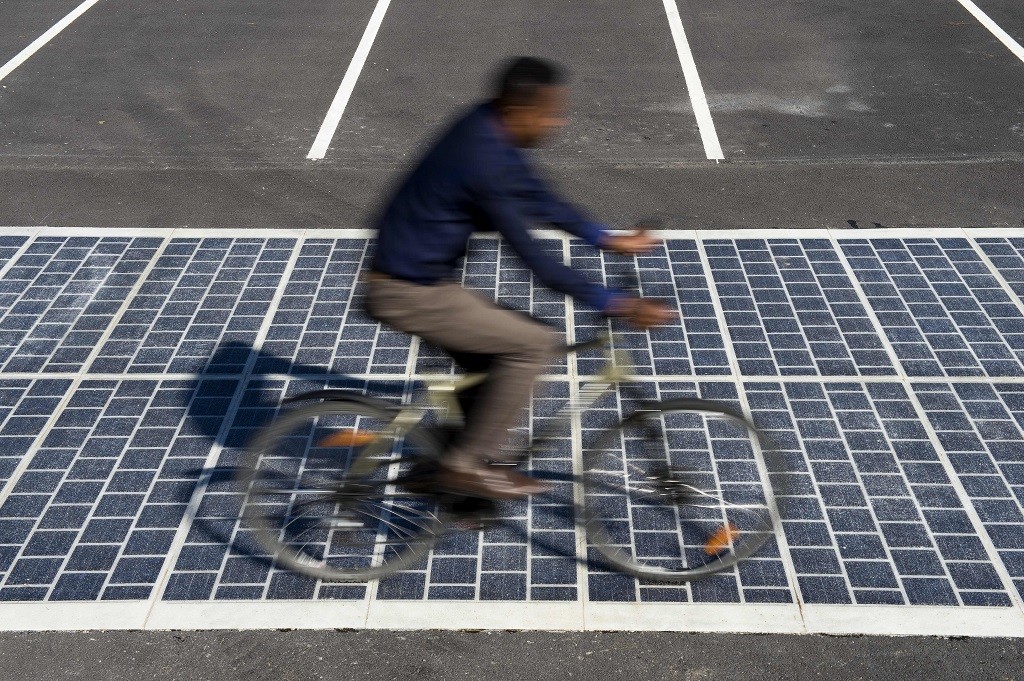Wattway, the photovoltaic asphalt that produces energy

wattwaybycolas.com
Since many years the ‘Power Roads’ concept is coming out, that is road, but also bridges and buildings that during years will give back to men the energy that they spent to build them, that will be able in the future to produce more energy than they spend. No more infinite asphalt castings, but turbines and solar panels on the sides of our roads are what designers and people who cares for the environment from all around the world deeply wish. But maybe they won’t wait too long: thanks to Wattway, this concept could become reality.
Indeed, thanks to the French drives, in the next years, on 1000 km and more of French roads, special photovoltaic panels will be lay down, made by Solar Energy National Institute (INES) and by Colas, a society specialized in transport infrastructures, that required 5 years of researching. The name of this new technology is Wattway and it consists of 7 mm thin and 15 mm large panels in which, in a substrate, some common polycrystalline silicon photovoltaic cells lay, capable of transforming solar energy in electricity. But the peculiarity of Wattway doesn’t consist in having the photovoltaic cells, but in the overlay that protects them both by atmospheric agents and, mostly, by cars and trucks deriving weights on the roads. Indeed, the cells are immerged in several strata of a special resin that assures the road control, preserves from tire wearing and, besides, it’s conform to thermic dilation, guaranteeing security and durability. Furthermore, these panels are rain resistant, developing a protection grade of IP66, and they passed easily the snow plough tests.

According to the company, their panels can last more than a conventional paving: from 10 years if the road is on average busy to 20 years if the road is lacking of traffic, such as parking and rest areas.
The other important newness of Wattway is its installation; indeed, no longer works or new operas will be needed, these panels can be directly pasted on the pre-existing pavement, with an exciting handiness.

But, of course, the strong point of Wattway is energetic saving. On average, a road is occupied by cars for the 10% of time, whereas for the rest of time it faces the sun, potentially accumulating great amounts of energy, mostly in summer. 20m² of these panels are capable of producing enough electricity to power a single habitation, 15 m² could be enough to power a traffic light, whereas a 1 km long road could power a 5000 inhabitants small town. According to Hervé le Boucchinì, Colas chief executive, if they installed these panels on 1000 km of French roads, they would cover the 10% of the national requirements.

Talking about efficiency, Wattway panels produce a 15% performance compared to a 18-19% performance produced by conventional photovoltaic panels; besides the cost is estimated to be 6 euro/watt, compared to similar technologies that cost approximately 2-8/watt.
Tests has started since much time and, according to Ministry of Transport, the panels installation is going to start in spring, to give the go-ahead to the ‘Positive-Energy’ initiative promoted by the French government, which, after the Paris agreement, will try to make the France to reach energetic self-sufficiency within 2050. When we talk about public works, citizens finance them. Indeed, the cost of gasoline, never been so low, is rising up in the next weeks, and should increase the public purse finances with 300 million euro, but which, at least, should be used for something innovative.
